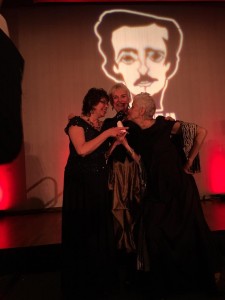
I’m just back from an amazing trip — two trips in one, to New York and Bethesda, MD, just outside Washington, D.C. Sisters in Crime received the Mystery Writers of America’s Raven Award for “outstanding achievement in the mystery field, outside the realm of creative writing,” and as the current president, I was honored to accept the award at MWA’s Edgars Awards dinner last Thursday in New York.
 When I arrived at Malice at noon Friday, a board member greeted me by saying, “I heard you kicked ass.” Well, maybe, in a sparkling navy gown, black kitten heels, and a purloined necklace. So, since I’ve been asked for the acceptance speech, here it is — and here I am with immediate past president Catriona McPherson and past president/founding mother Sara Paretsky.
When I arrived at Malice at noon Friday, a board member greeted me by saying, “I heard you kicked ass.” Well, maybe, in a sparkling navy gown, black kitten heels, and a purloined necklace. So, since I’ve been asked for the acceptance speech, here it is — and here I am with immediate past president Catriona McPherson and past president/founding mother Sara Paretsky.
UPDATE: There’s video! Watch it at your own risk!
Thank you.
This award is a tribute to the vision that a roomful of women crime writers had nearly 30 years ago, and it’s a most fabulous prelude to our birthday celebration, which we’re beginning this fall. That it comes from our partners in crime makes it especially fitting, and especially wonderful.
This award also acknowledges all the officers, chapter leaders, and members who have made Sisters in Crime a true sisterhood, and who have done the hard work of bringing about change – bettering the lives and careers of all crime writers, because when women prosper we all prosper.
And in that spirit, I would like to ask everyone in the room who is a member of Sisters in Crime, including our brothers in crime, to please stand, and let me thank you.
And to the rest of you, we can take care of that.
I’d like to thank the past presidents and current board members here tonight:
Sara Paretsky, past president and a founding mother,
Margaret Maron, past president,
Catriona McPherson, immediate past president,
and Lori Roy, our treasurer.
I also want to acknowledge our Executive Director, Beth Wasson, who is not here tonight. She will be at Malice Domestic this weekend, so if you’re headed down there, please congratulate her when you see her. Sisters would not be what it is without her.
Of course, there is still work to be done.
When a man says he won’t read a book by a woman, there is work to be done.
When a bestselling male author says from the stage at a major writers convention that women cannot write thrillers, there is work to be done.
And when there are white readers, some of them writers, who can’t tell you when they last read a book by an author of color, there is work to be done.
And so, we will continue doing the work for the next 30 years, and more.
Thank you for giving us the wings.
(I’ll tell you more about the rest of the trip, including the weekend at the Malice Domestic Mystery Convention later this week.)



 “In anything fit to be called by the name of reading, the process itself should be absorbing and voluptuous; we should gloat over a book, be rapt clean out of ourselves, and rise from the perusal, our mind filled with the busiest, kaleidoscopic dance of images, incapable of sleep or of continuous thought.”
“In anything fit to be called by the name of reading, the process itself should be absorbing and voluptuous; we should gloat over a book, be rapt clean out of ourselves, and rise from the perusal, our mind filled with the busiest, kaleidoscopic dance of images, incapable of sleep or of continuous thought.”
 “The books that we re-read the oftenest are not always those that we admire the most; we choose and we revisit them for many and various reasons, as we choose and revisit human friends.”
“The books that we re-read the oftenest are not always those that we admire the most; we choose and we revisit them for many and various reasons, as we choose and revisit human friends.”
 When I arrived at Malice at noon Friday, a board member greeted me by saying, “I heard you kicked ass.” Well, maybe, in a sparkling navy gown, black kitten heels, and a purloined necklace. So, since I’ve been asked for the acceptance speech, here it is — and here I am with immediate past president Catriona McPherson and past president/founding mother Sara Paretsky.
When I arrived at Malice at noon Friday, a board member greeted me by saying, “I heard you kicked ass.” Well, maybe, in a sparkling navy gown, black kitten heels, and a purloined necklace. So, since I’ve been asked for the acceptance speech, here it is — and here I am with immediate past president Catriona McPherson and past president/founding mother Sara Paretsky.